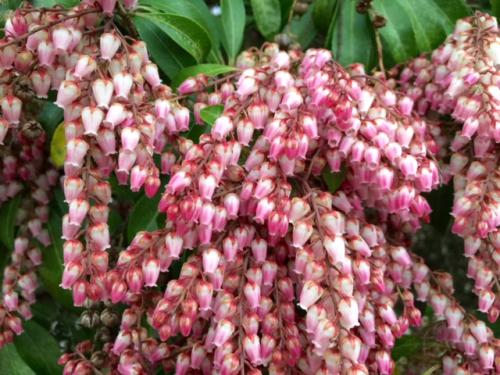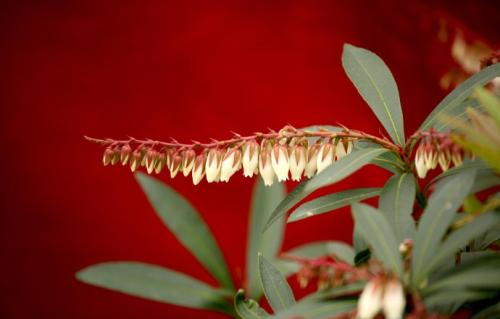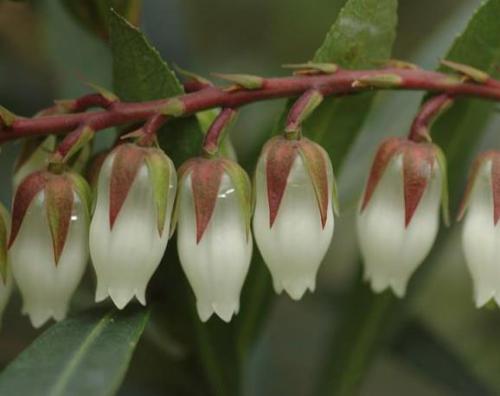The breeding mode of Majiu wood
The first way-cutting propagation
The most commonly used method of propagation is cutting propagation. First of all, the appropriate branches should be selected, then the branches should be cut off and dried for a few days, and then after the wound has healed, the branches will be inserted into the prepared soil, and then the soil will be kept moist. Finally, just wait for the tree to take root.
The second way-- sowing and reproduction
The sowing time is generally in the spring and autumn, the seeds should be healthy without any diseases, so that the germination rate can be improved, and the sowing temperature should be controlled at about 18 degrees, which is conducive to rooting and sprouting.

All right, the above is the breeding method of Majiu wood introduced by Xiaobian. I hope the breeding method of Majiumu that Xiaobian gives you can help you! Thank you for your reading!
The morphological characteristics and ecological habits of Euphorbia angustifolia
Horse drunken wood: evergreen shrub, 1 to 3 meters tall. Leaves clustered with branch ends, thickly papery, oblanceolate or lanceolate-long-elliptic, leaf margin serrulate; racemes; each inflorescence has 3-4 flower branches, densely pot-shaped florets, drape, Corolla white or white-green, capsule globose. The whole plant is poisonous, but the ornamental value of flowers and leaves is very high, so it is difficult to see large-scale planting in the wild. It can be used for cut flowers, bonsai, hedges and garden open field cultivation.
Horse drunken wood stems and leaves are poisonous, people and animals eat by mistake, which can lead to coma, dyspnea and dyskinesia.
Leaves are highly poisonous and their decoction can kill agricultural pests. The leaves are poisonous and can be used as insecticides. Toxic parts: stems, leaves and seeds. Poisoning symptoms: accidental ingestion of young children or livestock can cause coma, dyspnea, dyskinesia and even systemic convulsions.
The origin of the name: when a horse eats its branches and leaves by mistake, it will be poisoned, such as drunk, so it is called [horse drunken wood].
Morphological characteristics of Magnolia officinalis
Shrubs or small trees, ca. 4 m tall; bark brown, branchlets spreading, glabrous; winter buds Obovate, bud scales 3-8, arranged in imbricate shape. Leaves tufted with branch ends, thickly papery, oblanceolate or lanceolate-long elliptic, leaf margin serrulate Leaves leathery, densely branched apical, elliptic-lanceolate, 3-8 cm long and 1-2 cm wide, apex shortly acuminate, base narrowly cuneate, margin crenulate above 2 canes, sparsely entire, glabrous, surface dark green, abaxially light green, main veins raised on both surfaces, lateral veins impressed on surface, inconspicuous on abaxial surface, veinlets reticulate; petiole 3-8 mm long, ventral deep sulcate, abaxially rounded, puberulent. Racemes or panicles terminal or axillary, 8-14 cm long, erect or drooping, inflorescence axis pilose; each inflorescence has 3-4 flower branches, densely pot-shaped florets, drape, Corolla white or white-green, capsule globose. Sepals triangular-ovate, ca. 3.5 mm, ca. 1 mm wide, inner surface sparsely pubescent, outside with a few glandular hairs or subglabrous; Corolla white, altar-shaped, 6-7 mm long, ca. 5 mm in diam., glabrous, upper shallowly 5-lobed, lobes suborbicular; stamens 10, ca. 3.5 mm, filaments slender, villous, base more; ovary subglobose, glabrous. Style slender, ca. 6 mm, stigma slender, capitate. Capsule suboblate, 3-5 mm in diam., glabrous. Florescence: January-March; pale green; fruiting period is July-February capsule, brown.
Evergreen shrubs or small trees, 2-4 m tall. Bark brown, branchlets spreading, glabrous; winter buds Obovate, bud scales 3-8, imbricate arrangement. Leaves densely concentrated at top of branches; petiole 3-8mm long, with deep grooves on ventral surface; leaf blade leathery, elliptic-lanceolate, or oblanceolate, 3-8cm long and 1-2cm wide, apex shortly acuminate, base narrowly cuneate, margin 2 Greens, abaxially light green, main veins raised on both surfaces, lateral veins impressed on surface, abaxially inconspicuous, veinlets reticulate. Racemes or panicles terminal or axillary, clustered at the top of branches, 8-14cm long, inflorescence axis pilose; sepals triangular-ovate, ca. 3.5 mm; Corolla white, altar-shaped, distally 5-lobed, lobes suborbicular; stamens 10, filaments villous; ovary 1, subglobose, style slender, stigma capitate. Capsule suboblate, 3-5mm in diam., loculicidally dehiscent, calyx persistent with style. The florescence is from April to May and the fruiting period is from July to September. Ma drunk wood likes moist, semi-overcast environment, afraid of strong light exposure, cold resistance. It can survive the winter in the open air at a low temperature of-27 ℃, resistant to pruning and strong sprouting. Most varieties of drunken wood have low requirements for the environment and are easy to grow. Ma drunk wood likes moist, semi-overcast environment, afraid of strong light exposure, cold resistance. It can survive the winter in the open air at a low temperature of-27 ℃, resistant to pruning and strong sprouting.
Ecological habits of Majiu Mu
Sunshine: planting on flat land should avoid the strong direct sunlight of high temperature
Management: the suitable temperature for childbearing is about 1525 degrees C.
Moisture: the cultivated soil quality is better in humus-rich loam or sandy loam, and the drainage is good.
Ma drunk wood likes moist, semi-overcast environment, afraid of strong light exposure, cold resistance. It can survive the winter in the open air at a low temperature of-27 ℃, resistant to pruning and strong sprouting. Most varieties of drunken wood have low requirements for the environment and are easy to grow.
The function and use of horse drunkenwood
The whole plant is poisonous, but the ornamental value of flowers and leaves is very high, so it is difficult to see large-scale planting in the wild. It can be cultivated in cut flowers, bonsai, hedgerows and gardens; stems and leaves are poisonous, which can lead to coma, dyspnea and dyskinesia. Leaves are highly poisonous and their decoction can kill agricultural pests.
The Variety Classification of Majiu
Pieris formosa (Wall.) D. Don
Magnolia mandshurica (Picture of higher plants in China) Xingshan Majiu (Chinese Tree Taxonomy), long Bud Majiu (Xizang Flora, Yunnan Flora)
Evergreen shrubs or small trees, 2-4 m tall; branchlets Terete, glabrous, with leaf scars on branches; winter buds small, ovoid, scale outside glabrous. Leaves leathery, lanceolate to oblong, sparsely oblanceolate, 4-10 cm long and 1.5-3 cm wide, apex acuminate or acute, margin serrulate, base cuneate to obtusely rounded, surface dark green, abaxially light green, midvein conspicuous, puberulent on surface when young, glabrescent when old, lateral veins sunken on surface, inconspicuous on abaxial surface; petiole 1-1.5 cm long, ventral grooves, abaxially rounded. Racemes clustered in leaf axils at the top of branches, or sometimes terminal panicles, 4-10 cm long, sparse to more than 20 cm; pedicels pilose; sepals broadly lanceolate, ca. 3 mm; Corolla white, altar-shaped, pilose outside, shallowly 5-lobed distally, lobes obtusely rounded; stamens 10, filaments linear, ca. 4 mm, white pilose, anthers yellow. Ovary oblate, glabrous, style ca. 5 mm, stigma small, capitate. Capsule ovoid, ca. 4 mm in diam.; seeds yellow-brown, fusiform, Testa cells elongated. The flowering period is from May to June and the fruiting period is from July to September.
Produced in Zhejiang, Jiangxi, Hubei, Hunan, Guangdong, Guangxi, Sichuan, Guizhou, Yunnan and other provinces and regions. Born in thickets 90-2300 meters above sea level. There are also Vietnam, Myanmar, Nepal, Bhutan and India.
Pieris swinhoei Hemsl.
Shrubs, 2-3 m tall; bark gray-brown, longitudinally lobed, branchlets slender, puberulent; winter buds not seen. Leaves clustered; branches apical, leathery, narrowly lanceolate, 4.5-8 cm long and 1-1.5 cm wide, apex shortly acuminate, base narrowly cuneate, margin sparsely serrate above middle, slightly revolute after drying, surface dark green, abaxially light green, both surfaces glabrous, midvein conspicuous on surface, raised abaxially, lateral veins nearly horizontal, veinlets reticulate, conspicuous; petiole very short, 2-7 mm long. Racemes or panicles bearing apical branches or leaf axils, erect, 15-20 cm long; pedicels ca. 5 mm, pilose; sepals long, leathery, lanceolate, 5-7 mm long, 3-4 mm wide, inner surface pubescent, especially near top; Corolla white, cylindric jar-shaped, ca. 1 cm long, ca. 5 mm in diam., glabrous, distally 5-lobed, upper lobes obtusely round. Stamens 10, included, ca. 6 mm, filaments linear, subglabrous; ovary conic, ca. 2 mm, ca. 1.5 mm in diam., densely yellowish brown pubescent; style slender, ca. 7 mm, stigma slender, puberulent. Capsule subglobose, ca. 5 mm in diam. The florescence is from April to June and the fruiting period is from July to September.
Produced in Fujian, Guangdong and Hong Kong. Born in bushes. The type specimens were collected from Xiamen, Fujian.
Colourful leaf horse drunken wood
The colored-leaf horse drunken wood is the most popular courtyard colored-leaf tree species in Europe, America and Japan, which can observe both leaves and flowers, which meets the requirements of new and excellent varieties in Chinese garden application and has great market potential.
Euphorbia angustifolia is the cultivated variety or variety of Japanese Pierisjaponica and the hybrid between Ericaceae and Taiwan. it belongs to Azaleaceae and belongs to evergreen broad-leaved shrubs or trees. The varieties introduced in China can be divided into two series: leaf viewing and flower viewing. According to the leaf color, the Guanye series can be divided into three series: red leaves, flower leaves and green leaves. The flower series can be divided into two series: safflower and white flower. In the blooming season, the safflower series is colorful and colorful; the white flower series is like a cloud waterfall, fresh and elegant. The bark of the colored-leaf horse drunken wood is gray or brown, with longitudinal and scaly lines.
The leaf surface is leathery and flexible, mostly alternate, lanceolate to oblanceolate, or long elliptic, serrated? Young shoots are often red, bronze, copper, orange or yellow. The leaf color of most of the cultivated varieties changes with different growth periods, and the same plant will have colorful leaves such as red, pink, light yellow and green at the same time, which is of great ornamental value. The flower posture of the colored leaf horse drunken wood has a unique charm, and the white florets are born on racemes or panicles, like hanging bells. Inflorescences terminal or axillary, erect or pendulous. The flowers are white, sometimes pink and fragrant. From February to May, the calyx is yellowish green or yellowish brown, sometimes light reddish brown.
The breeding mode of Majiu wood
Seed, cuttage or ramet propagation.
Planting and maintenance of drunken wood
Magnolia mandshurica has beautiful plant shape, changeable leaf color, pink inflorescence, very charming, cold-resistant, wind-resistant, pollution-resistant, strong germination and an excellent ornamental evergreen shrub in the city. it is also widely used in indoor potted plants and small courtyards in Europe and Japan. Majiu is an evergreen shrub native to China and Japan, with a height of 4m and a width of 3m, with narrow Obovate to elliptic leaves: panicle, ca. 15cm, bell-shaped flowers, white, drooping or semi-erect, late winter and spring flowering; can withstand a low temperature of-15 ℃.
First, breeding techniques. ① sows and propagates. The seeds were sowed in pot in spring and autumn, the optimum temperature for germination was 13 ℃ ~ 18 ℃, and germinated 30-40 days after sowing. ② cuttage propagation. Softwood cuttings were used in early summer, semi-mature wood cuttings were used at the end of summer, panicle length was 8cm~10cm, room temperature was kept at 20 ℃ ~ 24 ℃, and rooting was 25-30 days after cuttage. Treatment of the base with indole butyric acid of 5g/L for 2-3 seconds could promote rooting.
Second, choose soil. The young leaves of Magnolia lanceolata are colored, with red, pink, pink green, tender yellow, orange and other colors. When planted in a small courtyard, it is appropriate to choose acidic sandy loam with high topography, good drainage, fertile and rich in humus, and row spacing 2m~3m. Potted plants can be prepared with garden soil, sand and barnyard manure at 6:2:2.
Third, apply fertilizer scientifically. Sex likes warm, moist and semi-overcast environment. Keep the soil moist during the growth period and apply 21-7-7 acid fertilizer once a month. In winter, the tree crown is ditched and fertilized, covered with a layer of bark, and kept warm for the winter.
Fourth, the temperature should be suitable. Horse drunken wood is more cold-resistant, afraid of high temperature and strong light exposure, growing into 10 ℃ ~ 15 ℃, cold-tolerant species can withstand 15 ℃, and general species can tolerate 5 ℃.
The Flower language of Ma Zuimu
Sacrifice dangerous and pure love
After reading the above introduction about the morphological characteristics and ecological habits of Majiu wood, do you know more about its morphological characteristics? if you want to know more about it, please continue to pay attention.
How does the drunken wood breed?
The breeding mode of Majiu wood
There are many ways of propagation, including seed propagation and cutting propagation.
Cuttage Propagation of Magnolia lanceolata
Ma drunk wood is the most commonly used and most commonly used is cutting propagation, first of all, cutting propagation should be carried out in early summer, first select cuttings, use new twigs, cut the branches into cuttings of about 10 cm, and then keep the cuttings in a cool place for about 3 days.
The second is the basin soil for cuttage, which needs well drained and fertile acid sandy soil containing humus.
Finally, take out the cuttings, smear the bottom of the cuttings with 5g/L indolebutyric acid, and then insert them into the basin soil to help take root.
Sowing and Propagation of Horse drunkenwood
The sowing and reproduction of Magnolia lanceolata should be sowed in spring and autumn, and healthy seeds without diseases and insect pests should be selected when sowing, and the growth temperature after sowing and sowing should be about 18 degrees to promote rooting and sprouting.
After sowing, the drunken wood should be watered immediately, and then raised in a warm environment with light. Pay attention to ventilation. After a month, the drunken wood will take root and sprout.
Breeding management of Majiu wood
The reproduction and growth of Magnolia lanceolata needs fertile soil with good drainage, so attention should be paid to the selection of soil when propagating and planting.
To apply fertilizer scientifically and reasonably during the period of reproduction and growth, we must first ensure that the soil is moist and water should be watered when the soil is dry, but do not accumulate water and fertilize again. The fertilization management of Majiu wood is to apply 21-7-7 acid fertilizer once a month.
Secondly, in winter, a shallow trench should be opened on the periphery of the planting area, fertilizer should be sprinkled into it, and then covered with thin soil and covered with hay or tree sawdust to survive the winter safely.
Finally, pay attention to temperature management, warm with enough light, avoid strong light, and hot air temperature, high temperature, should be ventilated, spray water on the leaves to cool the growing environment.
- Prev

The culture method of Majiu wood
First, the temperature of horse drunk wood can not bear high temperature, afraid of direct light, the most suitable temperature for growth is 10 to 15 degrees. Second, fertilizing mahogany needs enough fertilizer when it grows, so fertilize it every once in a while, but be careful not to get on the leaves.
- Next

Can horse drunken wood be hydroponically cultivated? how long can it be fed? Culture methods and matters needing attention of Majiu wood
1. Soil Ma drunk wood likes acid sandy soil rich in decay, which is loose and good in drainage, which is suitable for the growth of horse drunken wood, and can also be made of garden soil and sand. 2. Fertilizing the drunken wood needs enough fertilizer when it grows.
Related
- Fuxing push coffee new agricultural production and marketing class: lack of small-scale processing plants
- Jujube rice field leisure farm deep ploughing Yilan for five years to create a space for organic food and play
- Nongyu Farm-A trial of organic papaya for brave women with advanced technology
- Four points for attention in the prevention and control of diseases and insect pests of edible fungi
- How to add nutrient solution to Edible Fungi
- Is there any good way to control edible fungus mites?
- Open Inoculation Technology of Edible Fungi
- Is there any clever way to use fertilizer for edible fungus in winter?
- What agents are used to kill the pathogens of edible fungi in the mushroom shed?
- Rapid drying of Edible Fungi

